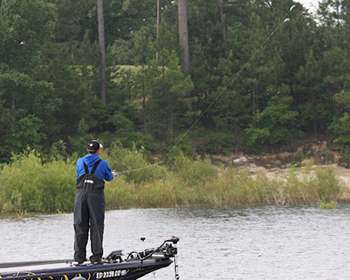
When the band Three Dog Night covered the song "One Is the Loneliest Number," it's safe to say that they weren't singing about fishing a soft plastic minnow bait called the Fluke. However, the way that Elite Series pro Marty Robinson fishes a Fluke, the 1969 hit might be applicable.
When the 2010 Bassmaster Elite Series visited Clarks Hill Lake for the sixth stop of the regular season, Robinson utilized a double Fluke rig to secure a top 20 finish. The double Fluke consists exactly of what the name implies.
Rather than fish with a single bait, an additional lure is added just above the first lure, creating the appearance of a school of baitfish and offering a chance to catch two bass at once. "The main thing that I'm trying to do with the double Fluke rig is imitate a school of blueback herring," says the South Carolina pro. "I really like to work it fast across the surface to imitate a fleeing blueback herring."
To rig the double Fluke, Robinson starts by threading a barrel swivel on his line and then tying another barrel swivel to the end of his main line. He then attaches an 18- to 24-inch leader to the barrel swivel at the end of his main line and a 10- to 12- inch leader to the barrel swivel threaded on his line. He ties 4/0 hooks on each tag end and Texas rigs a weightless Fluke on each hook.
The result is a "lure" where one Fluke sits approximately 6 to 12 inches ahead of a second Fluke. Robinson says that the double Fluke rig casts extremely well and, when rigged properly, won't tangle or twist. "One of the best advantages of the rig is that I'm able to cover a lot of water with it," he explains. "With a single Fluke, you can cover just as much water, but if you call up a school of bass, you can only catch one. With the double Fluke, you can double your catch and land two at once."
The prospect of catching two bass on a single cast almost sounds too good to be true, but Robinson says that on clear water lakes like Clarks Hill, taking advantage of your opportunities is critical for success. "Once you draw the school off of the structure, it usually takes them a while to return," continues Robinson. "You just want to take every advantage that you can.
"There are a lot of times when I'll hook a fish on a double Fluke rig and take my time winding it back to the boat. Probably seven out of 10 times, another bass will get the second Fluke and you can catch two at a time."
While he primarily uses the double Fluke rig on lakes where blueback herring are the predominant forage, Robinson says the rig will work anywhere there are gizzard or threadfin shad. "It's a pretty easy deal because everyone would rather catch two bass instead of one.
Anytime you catch a bass on a Fluke, you can catch them on a double Fluke as well."
(Provided by Z3 Media)




